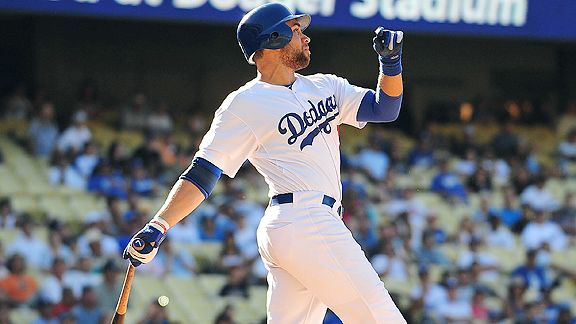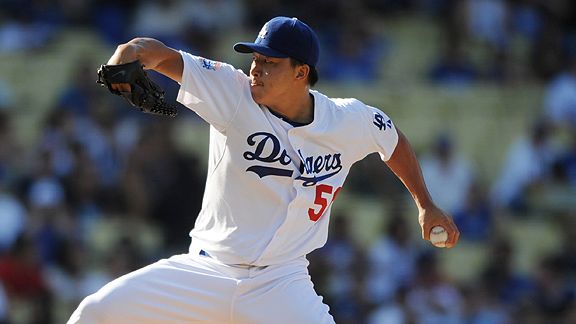I think I might always remember the moment, or approximate moment, that Jerry Sands was called up by the Dodgers. I was having an extremely rare weekday afternoon margarita at one of our big family gatherings of the week, and looking around the table at my wife reunited with her family and my kids with their East Coast cousins. To make a long story short, I’ve been having a hard time feeling optimistic about some things, but as I breathed in the scene, I suddenly not only told myself I should be more positive, I actually believed that I could.
That sentiment, I knew, might last little longer than the margarita, but lo and behold, I came out of the restaurant a couple hours later, quickly checked e-mails on my cellphone and saw that the Dodgers had made what could be a similar, happily desperate declaration in promoting Sands.
Sands, whose name I also came to realize today reminds me more of a slacks-wearing pro chipping in on the 18th hole to win at Pebble Beach, takes the roster spot of Xavier Paul, whom the Dodgers designated for assignment, as Tony Jackson of ESPNLosAngeles.com notes. That tradeoff in itself tells you the perils of placing faith in a minor leaguer to fill a gaping hole in the Dodger lineup. Paul was never a Dodger minor-league hitter of the year the way Sands was last year, but the guy had a fairly strong career in the Dodger farm system, only to go by the same wayside as (take your pick) Delwyn Young or Cody Ross.
So of course we keep our expectations of Sands as sober as I now find myself, especially on the on-base percentage side as he faces major-league pitching for the first time, less than a year out of Single-A ball. But his power nevertheless offers the possibility of something the Dodgers desperately need after cleanup hitter Matt Kemp: a threat. Until Juan Uribe and James Loney figure themselves out, why not Sands? It’s worth a shot, and even if he falls short, I expect the early exposure to the bigs will instruct more than it will harm.
What’s funny is as dramatic as this move might seem, we could see it coming months ago. From this winter’s “How close is he?” series:
Summary: From age 22 1/2 to age 23, Sands had a .395 on-base percentage and .586 slugging percentage with 35 homers in 590 plate appearances combined at Single-A Great Lakes and Double-A Chattanooga. In Double-A, Sands posted a .360/.529 with 17 homers in 303 plate appearances.
For comparison’s sake: From age 22 to age 22 1/2, Andre Ethier delivered a .383/.442 with seven homers in 471 plate appearances, all in Single-A. Then from age 23 to 23 1/2, Ethier offered .385/.497 with 18 homers in 572 plate appearances in Double-A (not counting a 17-plate appearance cup o’ joe at Triple-A). After starting 2006 strongly with the Dodgers’ Triple-A team, Ethier was promoted to the majors three weeks after turning 24.
Sobering: Sands struck out in about a quarter of his at-bats in the minors last year.
For what it’s worth: A younger Matt Kemp arrived in Los Angeles mere months after going .349/.569 in Single-A, and was in the majors for good less than two years after that Single-A year.
Quick and dirty conclusion: Obviously, Sands and Ethier are not the same player. Ethier had a better OBP but less power in the minors, among other differences. Still, I did find the juxtaposition interesting. It seems entirely plausible that Sands could get a quick promotion to Albuquerque in 2011. That would position him to make his big-league debut before the year is out and leave him a serious contender for a starting role in 2012.
Though there is almost zero chance Sands would start 2011 in the majors after only a half-season in Double-A – because Ned Colletti teams give veterans first crack in April – how Sands develops this year, against the background of how the Dodger major-league outfield shapes up, could speed up his timetable. He is also a potential understudy to James Loney.
We’ll see where Sands ends up ultimately. But tonight, I’m going to think positively. I could do worse.


 Gary A. Vasquez/US PresswireJames Loney, here hitting a game-winning 13th-inning home run in July against the Mets, is looking for his first month with a .500 slugging percentage since June 2008.
Gary A. Vasquez/US PresswireJames Loney, here hitting a game-winning 13th-inning home run in July against the Mets, is looking for his first month with a .500 slugging percentage since June 2008.


